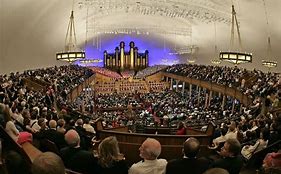
The singers of the choir must have adequately prepared themselves for the rigors of the Choir's schedule before even starting the audition process. Even those with terrific voices and musicianship might find throughout the audition process that the schedule is too demanding for their situation. Sometimes, qualified people will audition several times, continuing to work on their preparation (and waiting for a spot to open), before they are accepted into the Choir. Most of the choir members have had years and years of musical training and experience and have deliberately cleared their schedules so that they would be able to serve in the choir as unpaid volunteers for many, many years.
Rehearsals for us are at a higher level than for most other choirs. Every Sunday we prepare Music and the Spoken Word which is soon to start it's 85th year of continuous broadcasting. The songs chosen for the broadcast are usually a mix of hymns, anthems, master chorals, folk songs, and songs from the stage and screen. Some will be old favorites of our audience, some will go along with the Spoken Word message, and a few will be new or less well-known pieces. As our director says, "We sing for everyone." For us, this means, that by design, we will be familiar enough with a few of the songs so that we can sing them from memory, and then we will be allowed to use music for the new or less familiar pieces. Since the launch of our YouTube channel and the broadcast going out in High Definition though, we have been asked to memorize more and more of the songs. This is for production value. We just look and sound better with our eyes out of the music.
A lot can be said for production value. "The audience listens with their eyes," or so our conductors say. When the choir looks engaged in singing with interpretation and watching the conductor, the overall effect is grand. When I have worked with other choirs and small ensembles, I always tried to get them out of their music as soon as possible. When a group takes the time to memorize the music, they are also memorizing interpretation and showmanship. Audiences love a show. They love to be entertained. They like best what they already know, but if they are in the groove of feeling pleased, they will be accepting of the new and different as well. And when they have something to see as well as listen to, they are well-pleased and are likely to come back for more in the future. That's the whole concept of rehearsals. We work very hard at getting it right!
 RSS Feed
RSS Feed